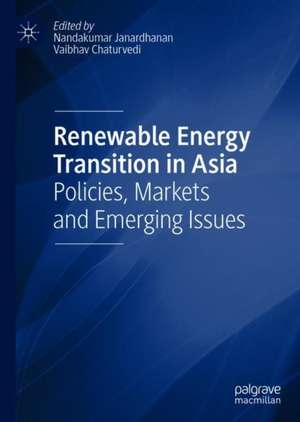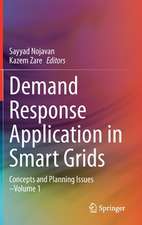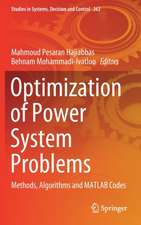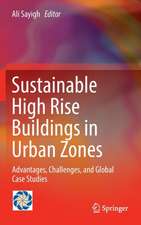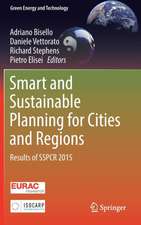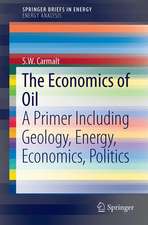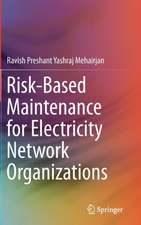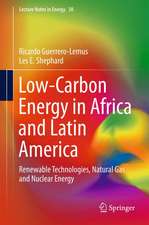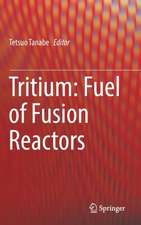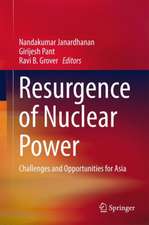Renewable Energy Transition in Asia: Policies, Markets and Emerging Issues
Editat de Nandakumar Janardhanan, Vaibhav Chaturvedien Limba Engleză Hardback – 13 feb 2021
The chapters focus on domestic policies, geopolitics, technology landscape and governance structure pertaining to the development of renewable energy in different Asian countries ranging from China to the Middle East. The book presents an insightful view of the pace and magnitude of the energy transition. It presents critical steps countries are taking to promote affordable and clean energy (SDG 7) as well as strengthening climate mitigation actions (SDG 13).
In addition, this book introduces the concept of co-innovation---a collaborative and iterative approach to jointly innovate, manufacture and scale up low-carbon technologies---and its role in promoting energy transition in Asia.
Chapter 8 (Renewable energy deployment to stimulate energy transition in the Gulf Cooperation Council) is available open access under a Creative Commons Attribution 4.0 International License via link.springer.com.
Preț: 730.35 lei
Preț vechi: 890.66 lei
-18% Nou
Puncte Express: 1096
Preț estimativ în valută:
139.75€ • 145.92$ • 115.40£
139.75€ • 145.92$ • 115.40£
Carte tipărită la comandă
Livrare economică 15-29 aprilie
Preluare comenzi: 021 569.72.76
Specificații
ISBN-13: 9789811589041
ISBN-10: 9811589046
Pagini: 292
Ilustrații: XVI, 292 p. 26 illus.
Dimensiuni: 148 x 210 mm
Greutate: 0.52 kg
Ediția:1st ed. 2021
Editura: Springer Nature Singapore
Colecția Palgrave Macmillan
Locul publicării:Singapore, Singapore
ISBN-10: 9811589046
Pagini: 292
Ilustrații: XVI, 292 p. 26 illus.
Dimensiuni: 148 x 210 mm
Greutate: 0.52 kg
Ediția:1st ed. 2021
Editura: Springer Nature Singapore
Colecția Palgrave Macmillan
Locul publicării:Singapore, Singapore
Cuprins
Part I Overview.- Chapter 1: Framing the Renewable Energy Context for Asia.- Part II Technology and Politics.- Chapter 2: Leveraging Co-innovation model for energy transition: Examining India-Japan-China Engagement.- Chapter 3: India’s Renewables Commitments: A Political Risk Assessment.- Part III Policy and Markets.- Chapter 4: The role of the International Solar Alliance in advancing the energy transition in Asian countries.- Chapter 5: Green industrialisation: Renewable energy development, export led industrialisation, and its implications for climate strategies in Asian developing countries.- Chapter 6 Dynamics of renewable energy in China: drivers and challenges.- Chapter 7: Historical Evaluation of the Korean New and Renewable Energy Policy.- Chapter 8: Renewable energy deployment to stimulate energy transition in the Gulf Cooperation Council.- Part IV Governance and Legal Aspects.- Chapter 9: Power Purchase Agreements as Instruments of Risk Allocation and Alleviation for Renewable Energy in Asia.- Chapter 10: A Tale of Two Cities: Governing Renewable and Low Carbon Transitions in Tokyo and Nagano, Japan.- Part V Energy Access.- Chapter 11: Achieving ‘Energy for All’: Solar Mini Grids for Rural Electrification in Asia.- Part VI Water-Energy Nexus.- Chapter 12: Water Energy Nexus: Shaping narratives across diverse issues in Asia.- Chapter 13: Potential Macro-economic Impact of the Expansion of Hydroelectric Sector in Central Asia.
Notă biografică
Dr. Nandakumar Janardhanan is a Research Manager of Climate and Energy Division and the Regional Coordinator for South Asia operations at the Institute for Global Environmental Strategies (IGES), Japan. He specialises in energy and climate policy and has research interests in energy security and geopolitics, renewable energy, low-carbon development and nuclear power. He has also been associated with several policy think tanks, research organisations and universities of international repute.
Dr. Vaibhav Chaturvedi is a Research Fellow at the Council on Energy Environment and Water (CEEW) and leads the Council’s ’Low Carbon Pathways’ research. Prior to joining the Council, he was a Postdoctoral Research Associate at the Joint Global Change Research Institute/ Pacific Northwest National Laboratory, USA. His research focuses on Indian and global energy and climate change mitigation policy issues within the integrated assessment modelling framework ofthe Global Change Assessment Model (GCAM).
Dr. Vaibhav Chaturvedi is a Research Fellow at the Council on Energy Environment and Water (CEEW) and leads the Council’s ’Low Carbon Pathways’ research. Prior to joining the Council, he was a Postdoctoral Research Associate at the Joint Global Change Research Institute/ Pacific Northwest National Laboratory, USA. His research focuses on Indian and global energy and climate change mitigation policy issues within the integrated assessment modelling framework ofthe Global Change Assessment Model (GCAM).
Textul de pe ultima copertă
This book covers critical debates on policies, markets and emerging issues that shape renewable energy transition in the Asian region, which is fast becoming an epicenter of the global energy consumption.
The chapters focus on domestic policies, geopolitics, technology landscape andgovernance structure pertaining to the development of renewable energy in different Asian countries ranging from China to the Middle East. The book presents an insightful view of the pace and magnitude of the energy transition. It presents critical steps countries are taking to promote affordable and clean energy (SDG 7) as well as strengthening climate mitigation actions (SDG 13).
In addition, this book introduces the concept of co-innovation---a collaborative and iterative approach to jointly innovate, manufacture and scale up low-carbon technologies---and its role in promoting energy transition in Asia.
Chapter 8 (Renewable energy deployment to stimulate energy transition in the Gulf Cooperation Council) is available open access under a Creative Commons Attribution 4.0 International License via link.springer.com.
The chapters focus on domestic policies, geopolitics, technology landscape andgovernance structure pertaining to the development of renewable energy in different Asian countries ranging from China to the Middle East. The book presents an insightful view of the pace and magnitude of the energy transition. It presents critical steps countries are taking to promote affordable and clean energy (SDG 7) as well as strengthening climate mitigation actions (SDG 13).
In addition, this book introduces the concept of co-innovation---a collaborative and iterative approach to jointly innovate, manufacture and scale up low-carbon technologies---and its role in promoting energy transition in Asia.
Chapter 8 (Renewable energy deployment to stimulate energy transition in the Gulf Cooperation Council) is available open access under a Creative Commons Attribution 4.0 International License via link.springer.com.
Caracteristici
The book explores how transitioning to renewable energy helps minimise the dependency on conventional fossil fuels Discusses the extent to which countries are able to ensure sustained growth of clean energy supply through the development of renewable sources Shows to what extent the conflict between renewable energy development and environment have been effectively addressed by policy mechanisms in the Asian region
